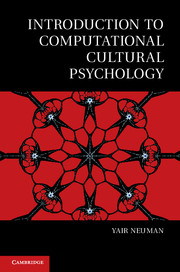Book contents
- Frontmatter
- Dedication
- Contents
- List of Figures
- List of Tables
- Preface
- Acknowledgments
- 1 What is computational cultural psychology?
- 2 The digital psychologist: information technology and cultural psychology
- 3 Why don’t primates have God? Language and the abstraction of thought
- 4 Lost in translation: how to use automatic translation machines for understanding “otherness”
- 5 Spies and metaphors: automatic identification of metaphors for strategic intelligence
- 6 Scent of a woman: the mediation of smell and automatic analysis of extended senses
- 7 Dolly Parton’s love lexicon: detection of motifs in cultural texts
- 8 The relational matrix of the I
- 9 Identifying themes: from the Wingfield family to Harry and Sally
- 10 Eating and dining: studying the dynamics of dinner
- 11 Getting even: the cultural psychology of revenge and what computers can do about it
- Epilogue: on generals and mail coach drivers
- Bibliography
- Author index
- Subject index
9 - Identifying themes: from the Wingfield family to Harry and Sally
Published online by Cambridge University Press: 05 June 2014
- Frontmatter
- Dedication
- Contents
- List of Figures
- List of Tables
- Preface
- Acknowledgments
- 1 What is computational cultural psychology?
- 2 The digital psychologist: information technology and cultural psychology
- 3 Why don’t primates have God? Language and the abstraction of thought
- 4 Lost in translation: how to use automatic translation machines for understanding “otherness”
- 5 Spies and metaphors: automatic identification of metaphors for strategic intelligence
- 6 Scent of a woman: the mediation of smell and automatic analysis of extended senses
- 7 Dolly Parton’s love lexicon: detection of motifs in cultural texts
- 8 The relational matrix of the I
- 9 Identifying themes: from the Wingfield family to Harry and Sally
- 10 Eating and dining: studying the dynamics of dinner
- 11 Getting even: the cultural psychology of revenge and what computers can do about it
- Epilogue: on generals and mail coach drivers
- Bibliography
- Author index
- Subject index
Summary
Introduction
The Glass Menagerie illustrated family dynamics in action. Family dynamics is only one instance of small-group dynamics. The study of small-group dynamics has long been of interest to psychologists and psychiatrists. From Bion (1961) to Foulkes (1964; see also Pines 2000), Yalom (1995), and others, the dynamics of small groups, such as the Wingfield family, have been carefully studied and mapped.
However, despite the rich insights gained into group dynamics, the techniques through which we can identify structural units of meaning (i.e., themes) emerging at the group level of analysis have remained largely unstructured. This observation is evident, for instance, in a wide range of the publications dealing with group psychotherapy from different theoretical and practical perspectives (e.g., Barnes et al. 1999; Berg-Cross 2000; Christner et al. 2007; Goldenberg and Goldenberg 2004; Rutan and Stone 2001).
We should remember here that in practice the therapist or group mediator observes the group dynamics in real time, and therefore the cognitive load under which s/he works impedes his/her ability to identify themes in a valid and empirically grounded way. Moreover, as the dynamics unfold, a complex network of signs is generated by the group. The complexity of this network imposes signii cant constraints on the ability of the group mediator to identify themes emerging from the discussion.
- Type
- Chapter
- Information
- Introduction to Computational Cultural Psychology , pp. 139 - 157Publisher: Cambridge University PressPrint publication year: 2014



